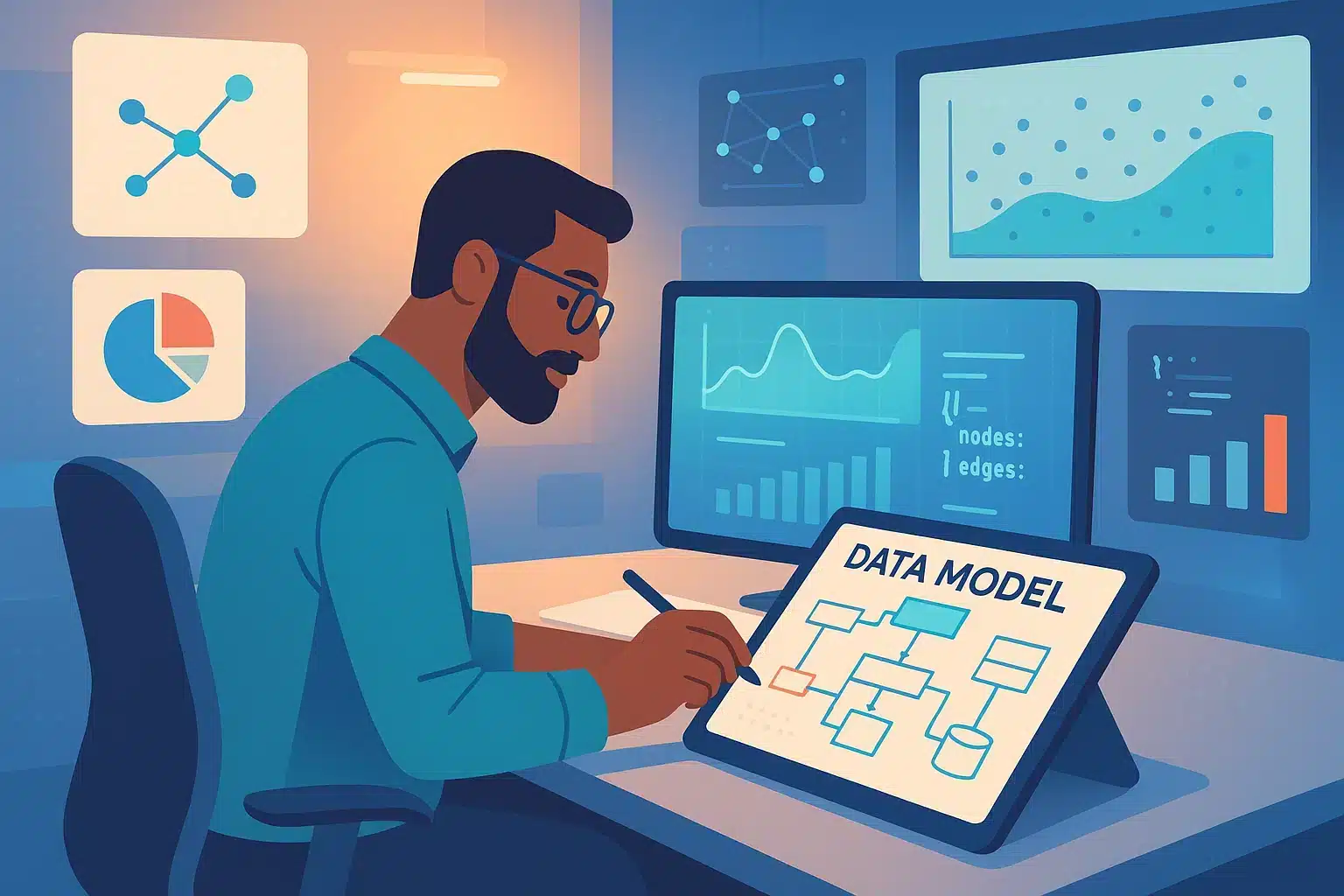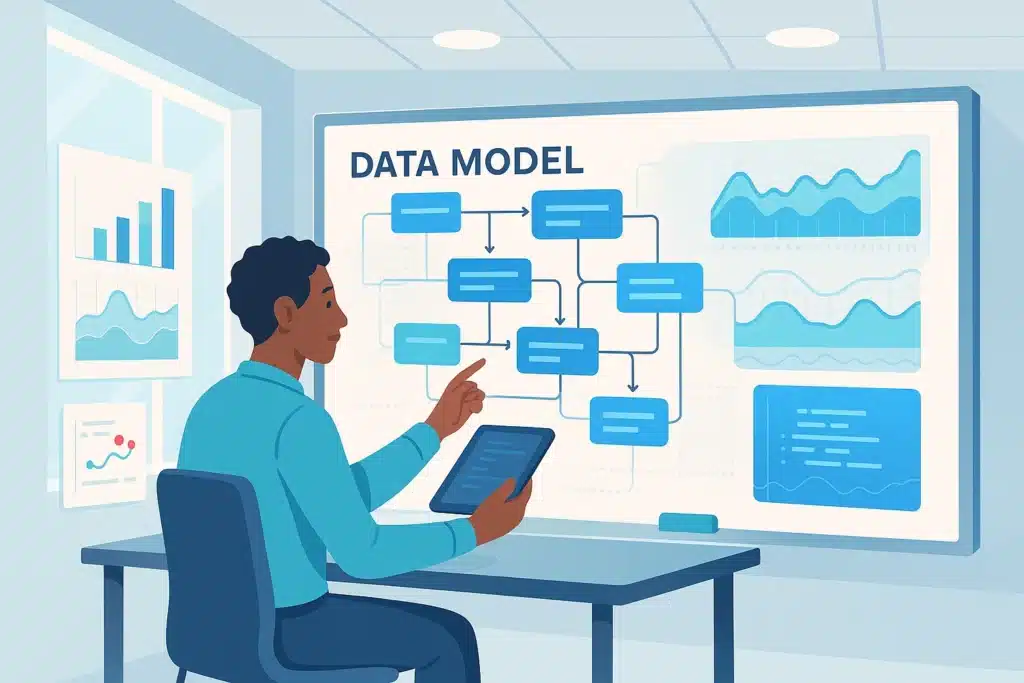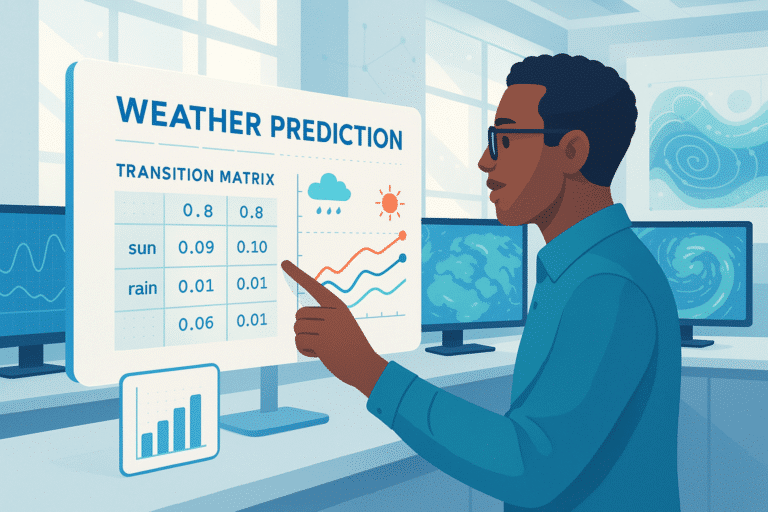Data Modeling is a frequently underestimated yet crucial step for the success of any data project. Discover what data modeling involves, the major types of models, and the best tools to use!
Collecting data is one thing, but the most important part is understanding it. However, raw data is often as valuable as it is indigestible. Structuring it to make it intelligible, reliable, and scalable? That’s where it all truly begins. That is the role of Data Modeling. It transforms chaotic streams into coherent, readable, and most importantly, durable schemas.
Whether it’s to feed a BI dashboard, design a solid relational database, or structure an AI-oriented data warehouse, it’s an essential step. Like an architectural plan, a good data model isn’t visible directly, but it determines the entire subsequent project.
What is data modeling?
Data Modeling involves formally representing the logical structures of data used in an information system. In other words, it’s a way to map out data, their relationships, and how they will be organized, stored, and manipulated. This representation unfolds over several levels.
The conceptual model, the most abstract, is used to represent business entities (customers, orders, products…) and their relationships, without technical constraints. It’s the “business language.” The logical model, on the other hand, structures the data more rigorously. It complies with the rules of a management system like SQL. Types, relationships, and cardinalities are defined…
With the physical model, we move to concrete implementation. Column names, indexes, primary and foreign keys… this is what will be truly deployed in the database. Each stage has a specific role. The conceptual model allows business teams and tech teams to understand each other.
The logical model brings coherency and robustness. The physical model optimizes performance and maintenance. Without Data Modeling, a database can quickly become an illegible patchwork, difficult to maintain, and a source of costly errors.

Major modeling approaches
Not all data models are alike. Depending on the use case (analytical, operational, NoSQL…), different approaches have emerged.
The ERD model
The classic among classics is the Entity-Relationship Diagram model. It is used to graphically represent entities (like “User”, “Order”) and their relationships.
For instance: “a user can place multiple orders”. It allows for modeling business rules clearly, even before considering the underlying technology.
Good to know: this model is often used to create the conceptual model, the first cornerstone of a good data project.
The relational model
With the relational model, entities become tables, attributes become columns, and relationships are ensured by primary and foreign keys. This is the dominant approach in SQL databases. Solid, time-tested, but rigid: it imposes a strict structure that must be carefully planned in advance.
The dimensional model
On the other hand, the dimensional model is designed for Data Warehouses. It is based on the separation between facts and dimensions. Two schemas are popular. First, the star schema, with a central fact table (for example “Sales”), linked to dimension tables (Client, Product, Time…). But also its more normalized version, the snowflake schema, where dimensions themselves are decomposed.
This type of modeling is widely used in BI, as it facilitates analytical queries and optimizes performance in reporting tools.
The NoSQL model
However, in the realm of NoSQL databases, it’s the document-oriented model that prevails. We forget complex relationships and store data as JSON documents, nested and flexible. An example with MongoDB: a customer record can directly contain their order history, without the need for joins.
This model shines for its flexibility in contexts of semi-structured data, but can quickly become a nightmare if the structure evolves poorly. Each approach has its advantages, but also its pitfalls. The whole point of data modeling is to choose the right model for the right use case and to know how to mix them if necessary. Indeed, hybridizing approaches is sometimes the best solution…

Data modeling and data architecture
Be careful not to confuse data modeling with data architecture. The two are often associated, sometimes even merged, but they address distinct issues.
Data modeling is above all a logical view of data: thinking in terms of entities, relationships, dependencies, business rules. It is a design activity, often carried out by a data analyst, data engineer, or data architect, with strong interaction with the business.
Data architecture, on the other hand, concerns the technical implementation of this vision. It involves tools, databases, pipelines, cloud, security, storage, and governance. It’s the technical skeleton that carries the data model into reality. Consider the data model as the house plan, and data architecture as the foundations, walls, materials, and plumbing.
Good modeling without thinking about architecture risks being unrealistic. Thinking about architecture without a model exposes chaos. Balancing the two is what makes the difference between a shaky data project and a reliable, maintainable, and scalable system.
Why does modeling change everything in a data project?
One might think that modeling is a boring formality, but it’s quite the opposite. Data modeling is the anchor point of the entire project. First reason: to ensure data quality. A good model imposes validation rules, avoids redundancies, and documents the sources. This allows for cleaner, more coherent, and thus more reliable data. The second reason is to facilitate collaboration.
With a well-designed schema, everyone speaks the same language. Businesses know what each table corresponds to, data analysts know how to query it, and data engineers know how to ingest it. No more need to decode obscure column names or patched-up structures. The third advantage, and not the least, is saving time (and money).
Fewer bugs, less confusion, fewer painful refactorings. The cost of a bad model isn’t immediately apparent. But it skyrockets as the project grows. Conversely, a good model allows for faster iteration and hassle-free scaling. Modeling also means anticipating. Anticipating future use cases, advanced analytics, machine learning, or cloud migration. A good data model is reusable and adaptable.

Business-first or tech-first?
In the jungle of data projects, a recurring question is: should one model starting from the business, or from the system? Business-oriented modeling, with a business-first vision, is the preferred approach in Business Intelligence, reporting, or strategic analysis projects. It begins with asking: what entities are important for the business? What relationships make sense for the users?
The model is designed to be readable, comprehensible, and usable by analysts and decision-makers. For example, in a marketing data warehouse, a simple structure is preferred, with clear dimensions like “Client”, “Campaign”, “Product”. And this, even if it means duplicating certain data to facilitate analyses. The goal is to gain simplicity and effectiveness in analytical exploitation.
Conversely, some projects require a more technical and normalized structure, designed to ensure operational coherence. This is where system-oriented modeling comes in. It’s often the case in transactional systems like ERP, e-commerce, or CRM. Highly normalized models are preferred, avoiding redundancy. Models optimized for raw performance, reliability, and maintenance. The aim is integrity, performance, and technical scalability. These two approaches are not opposed: they respond to different objectives. The art of data modeling is precisely about choosing the right approach according to the need.
The best modeling tools
Modeling is a real task of design, dialogue, and documentation. To do it well, it’s better to be well-equipped. Among the best tools, we can mention dbdiagram.io. Simple and visual, it is perfect to quickly start an ERD schema.
For more freeform and collaborative diagrams, one can use Lucidchart or Draw.io. There are also solutions designed for large systems, like ER/Studio or PowerDesigner. Tools like Metabase and Superset allow for visualizing data models and relationships directly from the database.
On the other hand, dbt (Data Build Tool) is heavily used to document and structure analytical models in modern data warehouses.

Data modeling in the era of cloud, AI, and NoSQL
Long confined to traditional relational databases, data modeling has had to adapt to the upheavals of the modern world: cloud computing, big data, machine learning, document-oriented databases…
The landscape has changed, and so have the practices. With machine learning pipelines, we no longer work solely with static databases. Data can be massive, noisy, and evolving. Thus, it’s necessary to model iteratively, maintaining maximum flexibility while ensuring traceability through data lineage and versioning.
Additionally, in MongoDB or Firebase, there are no tables in the SQL sense. Yet, modeling is more essential than ever. It requires thinking about document nesting, acceptable duplications, and read/write performance. Just because the structure is “free” doesn’t mean one should improvise.
Moreover, cloud-native modeling is designed for scalability. With solutions like Snowflake, BigQuery, or Redshift, the models must be frugal. They need to be parallelizable and adapted to pay-per-query. Cost, latency, cache, and even governance are considered from the start.
Data Modeling, key to a project that’s on track
Modeling your data is a bit like drawing the map before setting off on an adventure. Without a solid model, even the best tools or algorithms eventually run empty. Conversely, a well-thought-out base allows for gaining in efficiency, clarity, and most importantly, longevity. Good modeling today means avoiding technical debt tomorrow.
To master the fundamentals of data modeling, learn to structure robust pipelines and build modern data architectures, the Data Engineer training from DataScientest is simply ideal. It immerses you in all the gears of the trade: modeling, managing SQL and NoSQL databases, building ETL pipelines, orchestration with Airflow, massive data ingestion with Spark, cloud deployment…
In summary: everything a data engineer needs to know to build solid foundations. Thanks to our project-oriented approach, you’ll develop immediately applicable skills, directly related to field requirements. The training is certifying, professionalizing, and available in BootCamp, apprenticeship, or continuing education. Eligible for CPF and France Travail. Join DataScientest, and start building the data systems of tomorrow today.

Now you know everything about Data Modeling. For more information on the same subject, discover our complete article on Data Architecture and our article on data engineering.










